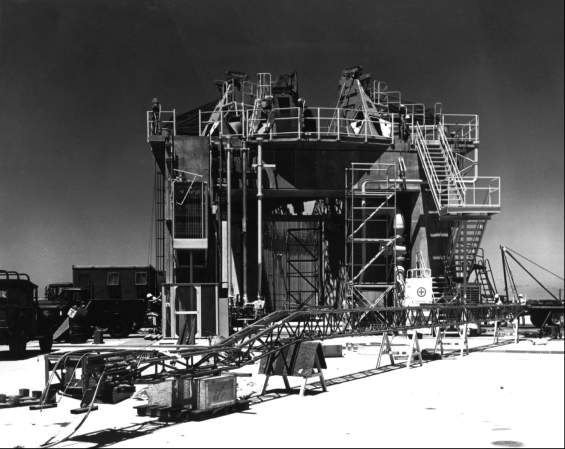
The Test Catalog for SA-1
LOD began preparing for the first Saturn launch in mid-March of 1961 when Debus directed the Scheduling and Test Procedures Committee to review launch procedures. The Director did not want to "automatically transfer into the Saturn, things that may have been important in past operations."11 The committee - composed of the operations office deputies Gorman, Moser, and Williams - agreed that Saturn required basic changes in launch procedures. For example, LOD personnel had conducted a detailed identification of component serial numbers on previous rockets. Since a serial inspection of Saturn components would require many man-hours, the committee proposed to rely on MSFC's detailed list instead. LOD would update the Marshall list when components were changed. The committee eliminated some redundant systems checkouts and recommended less component testing. During the Saturn C-1 launches, the emphasis would shift gradually from component testing to integrated systems testing. As the checkout for SA-1 was revised, other MSFC personnel undertook to coordinate all Saturn testing.12
The test catalog that emerged in May 1961 indicated the magnitude of the Saturn C-1 program. The catalog included 233 system tests, 102 of which were prepared by LOD. The tests were grouped in seven categories: electrical networks, measuring, telemetry, radio frequency and tracking, guidance and control systems, mechanical systems, and vehicle systems. The last category included overall tests, simulated flight tests, cooling systems tests, propellant loading tests, static firing, and fuel tank pressurization. Most of the tests ran from four to eight hours; a few required days. An example of LOD's contribution was 6-LOD-26, the fuel and LOX systems full-pressure tests: 6 indicated the category, mechanical systems; LOD, the responsible division; and 26 identified the particular test among 42 in that category. The test objectives were to "accomplish a pressure test of both propellant tanks to full working pressure, performed and monitored from the Blockhouse to determine if any major structural defects have occurred due to transporting, handling, erecting, etc. Pressure drop-off time, and pressure switch cycles will be recorded for system leakage analysis at full working pressures."13
While operations personnel were determining test requirements, construction at the launch complex progressed toward the 5 June 1961 dedication, when the Corps of Engineers would formally transfer LC-34 to NASA. LOD personnel began outfitting the service structure in early May. The propellants team used "live" fuel to run a "wet test" of the fuel system on the 19th, No serious leaks appeared in the LOX and RP-1 transfer lines, and the pumps worked satisfactorily. At the dedication ceremony the long cable mast and two short cable masts were the only major items missing, Redesign had slowed their development, but shipment from Huntsville was expected in mid-June.14

Assembling the long cable mast at LC-34.
A new ground support requirement, however, threatened to delay the October launch date. On 11 May launch vehicle designers notified Maj. Rocco Petrone's Heavy Vehicle Systems Office that the high-pressure gas system would have to be modified. Model tests indicated that LOX sloshing in the Saturn tanks caused condensation of the gaseous nitrogen used for pressurizing the fuel, and this lowered the pressure to marginal limits. The solution was to pressurize the LOX tanks with helium. Petrone took immediate steps to procure a helium facility through sole-source procedures - an emergency government purchase without competitive bidding. He transferred LC-37 funds to cover the expense and secured eight steelworkers, skilled in working on high-pressure tubes. Debus told von Braun the following day that the change to helium might hold up the launch. The Marshall director mentioned NASA Headquarters fear that a delay would have political repercussions, but assured Debus that Huntsville understood the problem. Modifications progressed rapidly, easing Debus's mind, and the helium facility was ready by mid- September.15
Up in Huntsville, the Fabrication and Assembly Engineering Division had fallen behind on its booster assembly schedule. Debus reluctantly agreed to have the work completed at the Cape. Albert Zeiler detailed a list of unfinished items in a letter to Debus on 14 July. Zeiler expressed particular concern about the scheduling problems posed by these requirements:
3 - Install hula hoops [rings that retained the heat shield] and coat uncoated portion on eight engines.
This would require 30 hours of unobstructed work in the tail section during the last 10 days before launch.
10 - Heat shield beams have to be coated, estimated time three days for application and up to ten days in addition where no work can be performed around the tail section because the coating discharges, during the curing time, burnable fumes.
Zeiler considered this a safety, as well as a scheduling, problem, but noted that the curing time could possibly be shortened.
11 - Four curtains for outboard engines will be prefitted, then coated, and then shipped.
The installation would require one day and should be done as late as possible to avoid any damage.16
Robert Moser was responsible for fitting the Fabrication Division's activities into the Saturn checkout. As SA-1 test conductor, he coordinated launch operations and ensured that proper procedures were used for the 102 formal tests. Moser's operations schedule, prepared in early August, included:
15 Aug. - Unloading barge and transporting S-1 stage to pad 34.17-21 Aug. - Erection of stages.
15 Sept. - Removing service structure for RE tests with the range.
20-25 Sept. - Overall systems tests.
2 Oct. - LOX loading test,
9 Oct. - Simulated flight test.
12 Oct. - Launch day.
Moser's schedule also listed much component testing and instrument calibration during the first half of the schedule; system and vehicle tests predominated in the second half. 17
12. Moser interview, 30 Mar. 1973; DDJ, 17 Apr. 1961,
15. DDJ, 11, 12 May 1961; "LFSEO Monthly Progress Report," 12 June 1961, p. 3.
16. Zeiler to Debus, "Work Statement," 14 July 1961.
| Next |